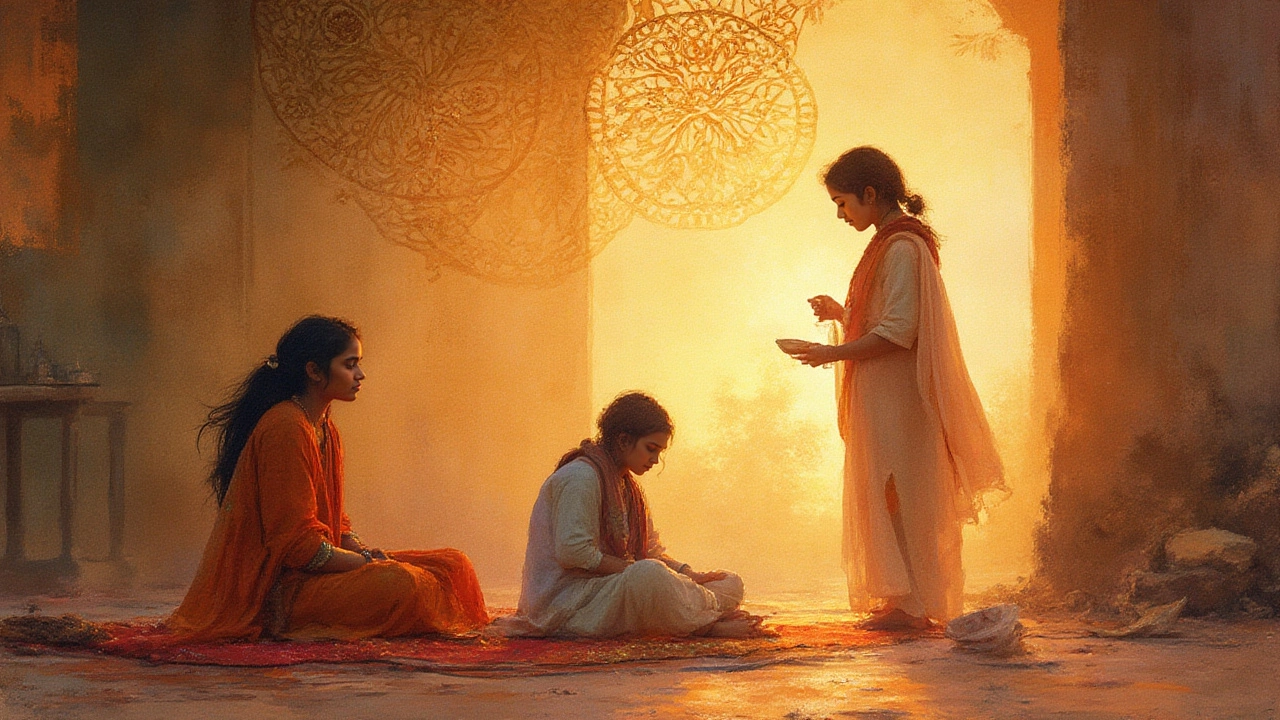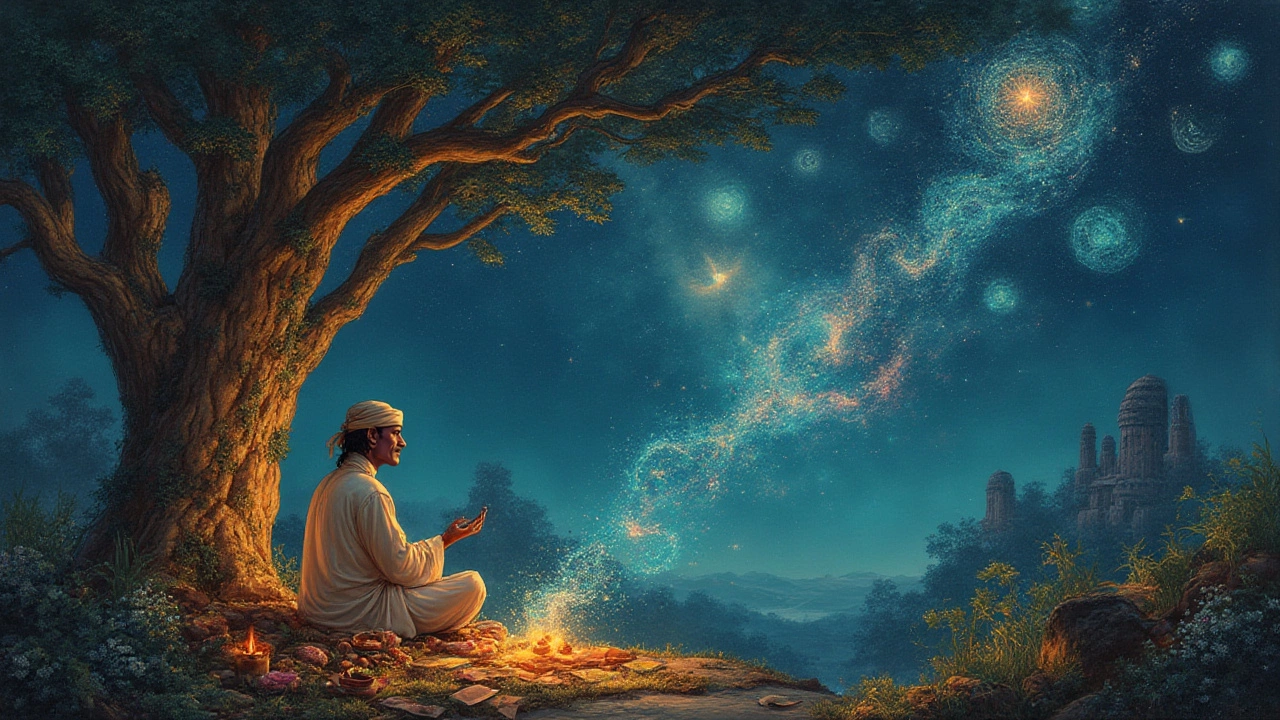Have you ever woken up after a wild dream and wondered if the universe was trying to tell you something? In India, that’s not just small talk over chai. Dreams have always held a kind of magic, threading together the everyday world with the mysterious and the spiritual. Across centuries, India has woven dreams into philosophy, religion, psychology, and even daily decision-making. The Indian philosophy of dreams isn’t just about wild stories your mind creates at night—it’s a whole worldview, mixing ancient texts, spiritual disciplines, and practical advice for living well.
Dreams in Ancient Indian Scriptures
Indian philosophy treats dreams as way more than random neural fireworks. Some of the oldest ideas about dreams come from the Vedas and Upanishads, ancient Sanskrit texts stretching back over 3,000 years. In these scriptures, reality itself is split into different states: the waking world (jagrat), the dream world (svapna), deep sleep (sushupti), and sometimes a mysterious fourth state called turiya. Each state has its own level of reality, and dreams get a lot of attention.
The Upanishads talk about dreaming like it’s a bridge. When you dream, you’re not fully awake, but you’re not in deep sleep either. In the Brihadaranyaka Upanishad—one of the oldest—it says a person creates his own dream world, complete with friends, gods, and fears—like a cosmic filmmaker. Yet, it’s not all fantasy. According to the Upanishads, your dreams can reflect your karma (actions), desires, and worries tucked away in your psyche. One interesting bit? It even suggests your true nature, the atman or soul, witnesses all of this from the background, unchanged by the dream.
Now, flip to another ancient text, the Chandogya Upanishad. Here, dreams are sometimes seen as omens. For example, dreaming about water can mean prosperity, while losing teeth can hint at anxiety or change. This dream-symbolism didn’t vanish centuries ago—it’s something some Indian families still swear by in 2025.
Indian philosophy of dreams wasn’t just theoretical. Sage Patanjali, the father of yoga, in his Yoga Sutras, actually defined dreaming as “fantasy without physical stimulus”—proof that thinkers were trying to crack the code of the dreaming mind. The connection between mind, dreams, and reality runs straight through Indian spiritual history.
| Text | Era | Key View on Dreams |
|---|---|---|
| Vedas | ~1500 BCE | Dreams as messages, omens, divine communication |
| Upanishads | ~900–600 BCE | Dreams reflect deeper mind, karma, and reality-states |
| Yoga Sutras | ~400 CE | Dreams as unrestrained imagination, product of the mind |
| Charaka Samhita (Ayurveda) | ~2nd Century BCE | Dreams as health indicators and mental states |
One recurring fact: ancient Indian doctors like Charaka even used dreams in diagnosis. For example, scary or violent dreams were thought to reflect imbalances in the body’s energies (called doshas in Ayurveda). Wild, right? Even thousands of years ago, dreams were as practical as they were mysterious.
Classical Interpretations and Folklore
Fast-forward from dusty palm-leaf manuscripts to the nooks and crannies of Indian homes today. Ask an elder about a dream—and get ready for stories. Indian classical texts didn’t just stick to big philosophy; they offered full-blown dream dictionaries. For example, the Swapna Shastra (Science of Dreams) and the Garuda Purana lay out endless details—if you dream about snakes, watch out for betrayal or enemies; if you see a lotus, good fortune may be ahead.
It’s not all superstition, though. The Mahabharata and Ramayana, two giant Indian epics, are sprinkled with dreams. King Dhritarashtra’s bad dreams foreshadowed disaster for his kingdom. In the Ramayana, Queen Kaikeyi’s dream led to epic twists and turns. These stories shaped the way common people related to their own night visions—dreams are warnings, advice, sometimes even cosmic nudges.
But step away from lofty tales, and you’ll find local customs. Some rural places still keep a dream diary by the bed, just as their ancestors did. There’s a knack for interpreting what you see—white animals mean peace, seeing the dead could mean blessings, or maybe you just dreamed about raw mangoes because you’re hungry. No joke.
Mix in India’s diversity and every region has its unique dream beliefs. In Bengal, seeing fish in a dream spells good luck. In Kerala, if you see yourself losing hair, old folks say you’ve got enemies plotting behind your back. Lots of traditions, but the idea stays the same—dreams aren’t ignored; they’re clues for navigating life, even if those clues feel cryptic sometimes.
Folklore aside, there’s also the nagging idea that dreams are not just entertainment—they might warn you, guide you, or make sense of the tangled emotions you hide during the day. In Indian homes, dream talk is a serious breakfast topic, with advice, gossip, and sometimes a trip to the temple if a dream felt too real.

Spiritual Practices and Dreams
In India, dreams aren’t just inner movies—they’re often seen as windows to something beyond normal life. Spiritual seekers want to hack their dreams for insight, growth, or even contact with the divine. This is where things get seriously interesting.
Yoga and meditation play a big part. Advanced practitioners sometimes use their dreams for “lucid dreaming”—being aware that you’re dreaming and even steering the plot. This isn’t a high-tech trend; references show up in texts like the Yoga Vasistha, which describes dream control as a path to self-mastery. Tibet’s Buddhist traditions, influenced by Indian masters, also talk about “dream yoga”—a practice for awareness and spiritual awakening. People chase after “samadhi” (deep meditation) by paying close attention to their dreams and even using them to solve real-life problems or spot subconscious fears holding them back.
Dreams in Indian spirituality are sometimes described as “maya”—the ultimate illusion. Saints like Sri Ramakrishna and Swami Vivekananda would say both waking and dreaming life are part of the same cosmic trick, so if you figure out the dream, maybe you start seeing through the entire illusion of life. Sounds deep, but the practical side shows up too. Many spiritual teachers recommend writing down dreams or quietly reflecting on their meaning during morning meditation. Ordinary folks might chant a mantra or burn incense to “clear” scary dreams or ask for guidance through their dreams.
One unique angle: many believe dreams can help you connect with ancestors or even deities. Festivals like Mahalaya in Bengal or Pitru Paksha in many parts of India include rituals where people offer prayers if they dream of a departed loved one. Grandma’s advice? If you dream that someone late in your family is asking for something, make sure you offer food in their name—just in case.
And here’s a concrete tip: Some yoga and spiritual teachers suggest eating light and sleeping early if you want more vivid or meaningful dreams. No heavy lentil curry before bed if you’re chasing spiritual insight! It’s half-joking, half-scientific, but there’s evidence lighter food can affect how you sleep and dream.
All of this isn’t just “old school.” A quick search on Indian YouTube channels or social media will find countless videos about dream signs, meditation before sleeping, and suggestions for dream journaling. The ancient meets the modern, and dreaming is still serious business.
Modern Views: Psychology, Science, and Pop Culture
India’s fascination with dreams didn’t stop in ancient times. In the last century, as psychology grew around the world, Indian thinkers started mixing old ideas with Freud, Jung, and modern science. Indian psychologists like Dr. Girindrasekhar Bose in Kolkata chatted with Sigmund Freud himself and even debated how dreams connect to culture and identity in India.
Modern India is full of dream talk. Newspapers carry dream horoscopes, TV astrologers interpret what your nightly show means, and therapists sometimes ask about recurring dreams as a way to tap into your subconscious. There are still old-style “dream books” at corner shops, but now, there’s even dream-interpretation apps in every major Indian language.
Science mostly sees dreams as products of your brain sorting out memories, emotions, and stresses. But surveys in 2024 show that 68% of urban Indians still believe dreams can tell the future or warn of real-life events. A 2023 Mumbai study found that 40% of young people discuss their dreams with friends or family, and almost half had acted on advice based on a dream at least once in the past year.
Indian movies love using dreams, too. Bollywood films often show lead characters guided by symbolic dreams—think “Barfi!” where a dream brings out secret desires, or “Tumbbad,” where disturbing dreams signal impending trouble. Songs, TV serials, even comic books riff on the idea that your dream life could flip your real life upside-down.
So, is it just culture? Or is there something deeper? Today, therapists draw inspiration from Ayurveda, yoga, and classic Indian theories about sleep and dreaming, telling clients that if you want to “decode” your dreams, start by keeping a journal—just like it’s been done for centuries. Science may not totally back prophetic dreams, but research shows dream recall and interpretation can help with stress, emotional problems, and even creativity.
Here’s a practical hack: Many sleep doctors now suggest Indian-style sleep routines—herbal teas, soothing oil massages, avoiding screens before bed, and even considering traditional lullabies—to help with deeper sleep and, yes, more vivid dreams. If you’ve got a pressing problem, some therapists recommend posing a question to yourself before bed and noticing what pops up in your dreams—an idea that links old folk tips with new psychology neatly.
Whatever your belief—divine messages, psychological puzzles, or brain clean-up crew—the Indian philosophy of dreams offers a toolkit for anyone hoping to make sense of the stories they see behind closed eyes. Whether you light incense, call your grandmother, or check a modern dream app, one thing’s clear: dreaming, in India, is anything but boring.
